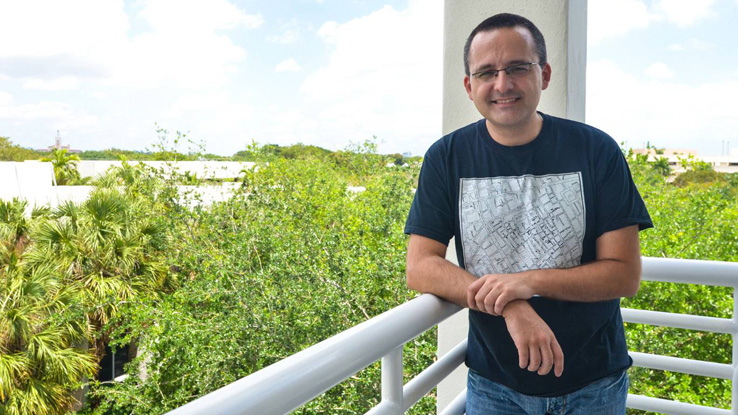
Coffee & Viz returns Sept. 4—at night!

The NCSU Libraries presents three free talks this fall as part of its popular Coffee & Viz series, including a special after-hours season kickoff on September 4 with visual journalist Alberto Cairo. Held in our high-tech spaces at the Hunt Library, the series provides a showcase for the unique ways that researchers at NC State and elsewhere are using visualization to enhance their work.
All Coffee & Viz programs are free and open to the public. For the morning events in the series, coffee and light refreshments from locally owned Anisette Sweet Shop will be available in an adjacent space beginning at 9:15 a.m. To increase the sustainability of this program, please consider bringing your own reusable coffee mug.
The Coffee & Viz fall 2018 season is as follows:
Coffee & Viz After Hours—“Visual Trumpery: A talk by special guest Alberto Cairo”
Tuesday, Sept. 4, 7:00 p.m.-8:00 p.m. in the Hunt Library Duke Energy Hall
Alberto Cairo, Knight Chair in Visual Journalism at the University of Miami and author of The Functional Art and The Truthful Art, brings his Visual Trumpery lecture tour to the NCSU Libraries. The very title of this talk, “Visual Trumpery,” is an example of its content. It is intended to trigger your ideological defenses and trick you into believing what is not so. For more on Cairo’s project, listen to this podcast.
The English word “trumpery” means worthless nonsense, something that is showy and deceitful at the same time. Trumpery can occur in text, verbally, or visually. This non-partisan talk focuses on the visual, examining misleading charts, graphs, and data maps designed by individuals and organizations from across the political spectrum. Cairo will use these examples to equip you with a solid understanding of “graphicacy,” the term he uses to refer to visual literacy, as he believes a literate, numerate, and graphicate citizenry is the best antidote for a world where trumpery runs rampant.
Free and open to the public; reserve tickets on Eventbrite.
“Making Tornadoes”
Friday, Sept. 21, 9:30 a.m.-10:30 a.m. in the Hunt Library Teaching and Visualization Lab
How do thunderstorms produce tornadoes? In this presentation, Dr. Matthew Parker of NC State’s Department of Marine, Earth, & Atmospheric Sciences will take you inside some of the most powerful storms on Earth via the high-resolution field work, models, and visualizations that researchers at NC State are using to understand how tornadoes are made.
“Enhancing Visualization of Storm Surge Guidance”
Friday, Oct. 19, 9:30 a.m.-10:30 a.m. in the Hunt Library Teaching and Visualization Lab
Coastal emergency managers use storm surge model forecasts as a critical tool for planning and decision making during storm events. These models must be both accurate and fast to provide reliable information in a timely manner as a storm moves toward the coast. Casey Dietrich, assistant professor in the Department of Civil, Construction, and Environmental Engineering, will discuss the development of an enhanced storm surge modeling process that incorporates high-resolution datasets and visualization techniques to produce more accurate storm surge forecasts that provide improved critical emergency management capabilities.
“Modeling the Chemical Space”
Friday, Nov. 16, 9:30 a.m.-10:30 a.m. in the Hunt Library Teaching and Visualization Lab
There are as many potential drug-like chemicals as stars in the whole universe. Synthesizing and testing all those compounds experimentally is impossible. Denis Fourches, assistant professor of Chemistry in NC State’s College of Sciences, will discuss the rise of cheminformatics and artificial intelligence to model, visualize, and virtually screen those chemicals for various applications in drug discovery, chemical risk assessment, and green chemistry.
“Comparative Visualization Using Ensemble Surface Slicing”
Friday, Nov. 30, 9:30 a.m.-10:30 a.m. in the Hunt Library Teaching and Visualization Lab
Dr. Christopher Healey, Goodnight Distinguished Professor in NC State’s Department of Computer Science, will provide an overview of how Ensemble Surface Slicing (ESS) can be used to directly compare different visual surfaces, and will provide examples of how ESS can be used for model debugging and detecting variations between multiple visual data sets.
Contact
Karen Ciccone
Head, Data & Visualization Services
919-515-3513
kacollin@ncsu.edu